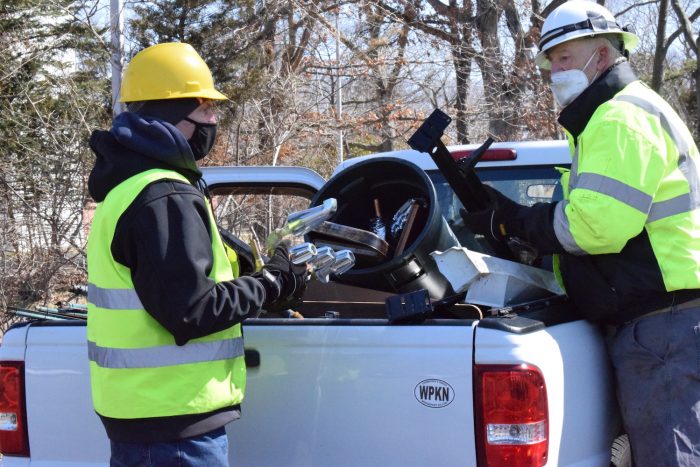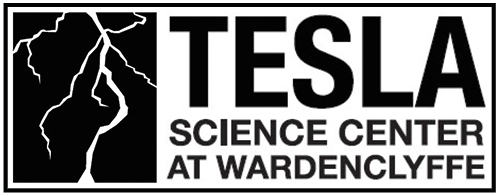Announcements

TBR News Media Article by Julianne Mosher – In an ongoing process to keep Nikola Tesla’s legacy alive on Long Island’s North Shore, the first-ever “Metal for Tesla” event was recently held, benefiting both the environment and the nonprofit’s cause.
The Tesla Science Center at Wardenclyffe, located in Shoreham, is Nikola Tesla’s last remaining laboratory. A sad, but interesting history, the lab has been working toward becoming a science museum, that celebrates science, along with the history and contributions of the famed scientist and inventor.
But the funds aren’t always easy to come by, and it’s taken the support from dozens of sponsors, fundraising, grants and crowdsourcing to get where they are today.
On Saturday, March 20 from 9 a.m. until 4 p.m., over 250 people attended the site and more than 16,000 people around the world shared the event to recycle in their areas and donate to the Tesla Center online. The center partnered with Gershow Recycling.
Science Center Executive Director Marc Alessi said they have recycled metal on the premise before, and since taking over the site, have recycled up to 62 tons (or 124,000 pounds) of metal. That has equated to be about $6,500.
This year, they raised approximately $9,500 in metal, plus the value of four cars, to support the rebuilding of Tesla’s lab into a museum and global science center for all.
“It’s money that goes toward the mission, which is rehabilitating the lab and opening it to the public,” Alessi said. “But the mission is also spreading Nikola Tesla’s ethos … he was someone that was advocating for sustainability, conservation and the use of renewable energies in the 1890s. And in retrospect, he was right on the money.”
A man before his time
Alessi said that during the height of Tesla’s career, people didn’t know what he was trying to do. Born in what is now Croatia, and of Serbian descent, Nikola Tesla immigrated to the United States in 1884.
“But he was a man of the world,” Alessi said.
He began working at the Edison Corporation, where he was immediately seen as a genius. Upon his research, he began realizing that alternating current systems — compared to Edison’s direct current systems — would be more beneficial and safer option.
“With one power plant, you can power many neighborhoods and factories,” Alessi said. “Under Tesla’s use of AC, and the way he put it together, it could power motors …. Direct current, you would need a power plant every two miles. Can you imagine what our environment would be like if they tried to electrify doing that?”
He believed that energy didn’t have to be a rich man’s luxury. Energy could be available to all and powered naturally. He believed he could power the whole Northeastern seaboard with Niagara Falls.
Tesla and Edison became engrossed in a battle, leaving Tesla to attempt to start his own company with plenty of struggle. Throughout his career, he had his ups and downs.
For example, Guglielmo Marconi used 17 of Tesla’s patents to help create his single transmission.
In the early 1900s Tesla acquired the Wardenclyffe property in Shoreham to test his theories of being able to wirelessly transmit electrical messages, funded by J.P. Morgan. The property housed a huge 187-foot tower for the purpose.
In 1903 creditors confiscated his equipment, and in 1917 the tower was demolished. The concrete feet used to hold the structure can still be seen on the property today.
Tesla was eventually cut off, causing him to lose control of the site. The property became a film processing company in the early 30s, where harsh chemicals were dumped into the ground. The contaminated property was sold again and became shuttered in 1987.
A decades-long cleanup ensued, and in 2007 the property was put back up for sale.
The community — locally, nationally and even internationally — came together to fundraise to buy the property, preserve it and make it a real historic site.
“They did a crowdfunding on Indiegogo, and at the time, it set a world record,” Alessi said. “They raised 1.4 million in six weeks, from 108 countries and 50 states — 33,000 donors,”
The site
Over the last few years, things have been moving along for the Tesla Science Center site. Through more fundraising and big-name sponsors (like the Musk Foundation, who contributed some money), plans are continuously on the way.
In September, renovations were completed on the chimney and cupola of Tesla’s historic laboratory, originally constructed by architect Stanford White in 1902. This project was funded by a grant from the Robert Lion Gardiner Foundation — a foundation here on Long Island that focuses on funding to restore historic sites.
Alessi said the project costs about $20 million and so far, $10.2 million has been raised. Permits with the town and DEC are still under review to begin working on the site’s visitor center — a small white house in the front of the property, which had nothing to do with Tesla. He’s hoping for the demo permit and the center to be completed this year.
“We will continue to raise capital,” he said. “We need at least five-to-10 million to finish the lab building and put exhibits there.”
Part of the process includes rebuilding the significant 187-foot tower that was once on the property.
“It was the tallest structure on Long Island, it went up almost 200-feet into the ground,” Alessi added.
Tesla had envisioned 14 towers around the world, with power plants similar to what the Wardenclyffe lab was.
“The beauty of it, is this guy wanted to provide free energy to everybody,” he said. “Imagine everybody having free power with 14 power plants. It’s a beautiful story — and that’s what the part of what the tower was supposed to be.”
Bringing the metal back
It all comes full circle, Alessi said, and it’s quite ironic.
“When Tesla lost control of the property, they demolished his famed tower, sold it for scrap and recycled it,” he said. “So now, we’re asking people to bring metal back to the site, so that we can restore the site, and one day we build the tower, too.”
Alessi said that since taking over the property, the center has always encouraged people to donate recycled metal to the bin on site. This year was the first time a whole event was dedicated to it.
“This is something we plan to do every year,” Alessi said. “It helps raise funding for the lab, but it also helps celebrate who Tesla was. I think it’s a really great event.”
And people can still continue to donate metal to the cause.
“This is a guy that in the 1890s said, ‘Don’t go down the path of coal … we need to be sustainable,” Alessi said. “We need to conserve, so it makes us feel like we’re making him proud by doing this on his site.”




